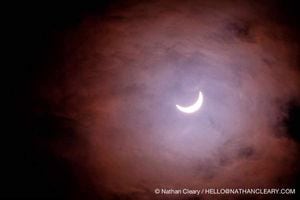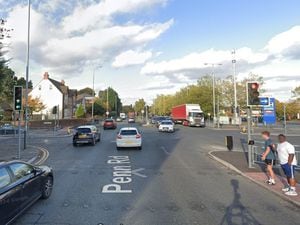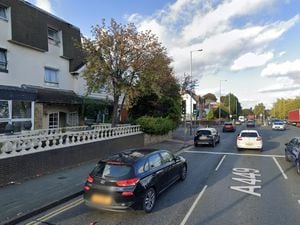Solar eclipse: Britain plunged into darkness by astronomical spectacle
[gallery] A near total solar eclipse of the sun brought a rare astronomical spectacle to the UK today that will not grace the skies again for another decade.

Across the Black Country and Staffordshire the eclipse was bringing out thousands of sky-gazers to witness the phenomenon as the moon starts to move in front of the sun shortly before 8.30am.
In the UK the proportion of the sun covered by the moon will increase towards the north, with 89.3 per cent covered in the Black Country.
The eclipse began at 8.25am and reaching its maximum effect at 9.31am, before ending at 10.40am.
And experts have promised an array of dazzling effects, including small crescents of light transposed onto the ground and an other-worldly chilly feel in the air as the sun becomes blocked out.
Simon Barnett, aged 49, of the Wolverhampton Astronomical Society, described what people can expect to see.
He said: "We're not going to get totality in the UK, you have to go to the Faroe Islands for that, but this is a very big eclipse.
"It's rare to get one of this magnitude. Nearly 90 per cent of the sun's diameter will be hidden by the moon, so the light will appear dimmed.
"A small crescent of the sun will appear visible, as if it's lying on its back with horns pointing upwards.
"Around 9am there will be a slight cold tinge in the air, as if someone has taken the edge off the sun's heat. There could also be a change in the sky's colour to the north.
"There will be a general gloom and the planet Venus could come into view in the east."
Mr Barnett, who will be viewing his third eclipse from his back garden in Cannock on Friday, added that extreme caution should be taken when staring at the sun.
A guide to safe eclipse viewing has been issued by the Royal Astronomical Society and the Society for Popular Astronomy.
The most important message is never to look directly at the sun even through sunglasses or dark material, such as a bin liner or photographic negative. Makeshift filters may not screen out the harmful infrared radiation that can burn the retina of the eye.
Here are some of the best safe methods of observing the magical moment when the moon and the sun align to start the eclipse.
Using a mirror: Cover a small flat mirror with paper which has a small hole cut in it. The hole does not have to be circular, but should be no wider than 5mm. A larger hole will produce a brighter, but fuzzier image.
Prop up or clamp the mirror so that it reflects the sunlight onto a pale screen or wall, ideally through a window. A projection distance of five metres – 16.4ft – will produce an image of the sun about 5cm across.
Do not look into the mirror during the eclipse as this is just as dangerous as looking directly at the sun.
A big advantage of this method is that it allows a number of people to watch the eclipse at the same time – ideal for schools.
The pinhole viewer: Pinholes allow light through them and can create an image like a lens. Make a small hole in a piece of card using a compass or other sharp-pointed implement. Standing with your back to the sun, position another white card behind the one with the pinhole so that the sun projects an image onto it.
Projection from binoculars or a telescope: Cover one eyepiece of a pair of binoculars with a lens cap and face the big end of the binoculars towards the sun. The uncovered lens will project an image of the sun that can be cast onto a plain card held about a foot away. Use the focus wheel to sharpen the image.
He said: "Under no circumstances should anyone gaze directly at the eclipse," he said. "Glasses with special filters should be worn, and even them I wouldn't recommend looking for more than a minute.
"Under no circumstances should people use a telescope or binoculars.
The Royal College of Ophthalmologists said looking directly at the Sun can lead to retinal burns and may cause significant and sometimes permanent loss of sight.
The Society says that dangers persist even if dark filters such as sunglasses or photographic negatives are used, while it warns that children should never look directly at the sun.
The dangers are exacerbated by the fact that the eclipse is set to take place in the middle of the morning rush hour, leading motoring organisations to warn drivers to take extra care if travelling during the eclipse.
But sky-watchers plans to watch the eclipse could be scuppered by overcast weather.
Mr Barnett said: "The forecast is not to brilliant and an anticyclonic gloom would cloud things up a lot.
"Whether or not the sun will poke holes through that is the luck of the draw."
A number of schools across the region are switching around timetables to allow students to see the event.
Students at The Royal School in Wolverhampton will be allowed to skip the morning church service to catch a glimpse of the eclipse under the guidance of the school's science tutors.
Holly Hall Academy in Dudley has provided students with free eclipse glasses and solar telescopes so they can watch the eclipse unfold.
Each year group will be taken out to see the eclipse in 20 minute slots, all under the watchful eye of design teacher Mark Townley, who has been an avid astronomer for more than 30 years.
He said: "The last major solar eclipse was in 1999 and the next one isn't until 2026 so it's important to give our students the opportunity to see it. The Earth, moon and sun are lining up and there's so much vast space in between them, it puts things in perspective.
"Space inspires all of us, it gets young people into Maths and Science and engineering and they'll be our future. It will be them, the next generation, who could be travelling to Mars."
At Dormston School in Sedgley students will be given special glasses and telescopes to safely observe the eclipse.
They can also look at the eclipse through reflections in buckets of water.
Chris Dudley, science teacher, said: "They're all excited about this. I was teaching about this 12 months ago, it's nearly a once-in-a-lifetime event.
"We're very much getting involved, we've got special glasses which are perfectly safe."
Total solar eclipses can be seen somewhere on Earth every 18 months on average, but are considered rare events that recur at any given location just once every 360 to 410 years.
A solar eclipse takes place when the earth, moon and sun are aligned and the moon's shadow touches the earth's surface.
Totality is only visible along a track a few hundred kilometres wide, and away from this path the sun is partly obscured.
Friday's partial eclipse will be visible across a large part of the northern hemisphere, including the whole of Europe, Greenland, Newfoundland, northern Africa and western Asia.





